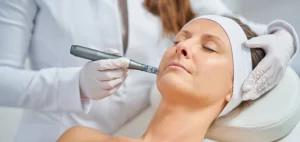Recent years have brought unprecedented stress levels to many – from the pandemic and heightened workload, to financial and social pressures. These unavoidable stresses often manifest physically, leading to unconscious teeth grinding and jaw clenching – a condition known as Bruxism.
Masseter Botox injections have become a popular treatment for this issue. Not only do these injections help you get rid of teeth grinding and the associated tension as well as the headaches; but they also offer unexpected cosmetic benefits, such as altering/adjusting facial shape.
In today’s blog, we’ll discuss Masseter Botox – let’s begin with understanding what is masseter botox and how it works.
What is Masseter Botox?
Masseter Botox is a non-surgical cosmetic procedure that uses Botulinum Toxin Type A (including brands like Botox, Dysport, Xeomin, and Juveau) to target the masseter muscles at the jaw’s angle. This treatment differs from typical Botox applications for wrinkles, involving higher doses and deeper injections into the masseter muscles. The effect of these injections is the relaxation of the overactive jaw muscles, leading to a more defined and slimmer facial profile while also alleviating associated muscle tension and discomfort.
Masseter Botox Procedure: What to Expect?
When having Masseter Botox administered, you can expect a relatively quick and minimally invasive procedure. The aesthetician will clean the targeted area at the angle of your jaw and may apply a topical anesthetic to minimize discomfort.
The aesthetician administers the Botulinum Toxin Type A using a fine needle, right into the masseter muscles. You might feel a series of small pinches during the injections. The entire session typically takes about 15 to 30 minutes. After the procedure, you can almost immediately return to most of your daily activities, with minor redness or swelling at the injection site, which should subside quickly.
How Long Does it Take to Recover?
The recovery period after a Masseter Botox treatment is typically swift. Most people can continue with their usual daily activities right after the procedure. However, it is recommended to avoid robust exercise, extensive facial movements, and lying flat for the next several hours following the treatment. These activities can cause the Botox to move from the targeted area, potentially leading to suboptimal results.
Benefits of Masseter Botox
- Facial Contouring: Softens the jawline by relaxing the masseter muscles, leading to a more V-shaped or heart-shaped facial profile.
- Reduction in Jaw Tension and Pain: Alleviates discomfort and tension in the jaw, beneficial for those suffering from teeth grinding or temporomandibular joint disorders (TMJ).
- Prevents Teeth Grinding: Helps reduce nighttime teeth grinding (bruxism), protecting against tooth wear and damage.
- Headache Relief: This can decrease the frequency and intensity of headaches, particularly those linked to jaw stress.
- Non-Surgical and Minimally Invasive: Offers a non-surgical alternative with minimal downtime, avoiding the complexities of surgical interventions.
- Quick Procedure and Results: The entire process takes about 15 to 30 minutes, with effects becoming noticeable within a week and lasting several months.
How Long Does It Last?
The effects of Masseter Botox typically last between 3 to 6 months. The duration can vary depending on several factors, such as the individual’s muscle strength, metabolism, the amount of Botox used, and the administration technique of the aesthetician. Regular follow-up treatments are recommended to maintain the desired aesthetic and functional benefits.
Who is the Ideal Candidate?
Ideal candidates for Masseter Botox include individuals with a bulky or square-shaped jawline often due to an overactive masseter muscle or muscle hypertrophy, which can arise from genetics, habit of teeth grinding or clenching, or excessive chewing gum use.
It is also well-suited for people with TMD disorders who prefer to explore non-invasive treatments before considering surgery. These individuals are generally healthy and aim to achieve a more slender, defined jawline through non-surgical means.
Candidates should have realistic expectations about the results, understanding that the treatment will not alter the bone structure of their jaw. Also, those with neuromuscular disorders, allergies to Botox components, or women who are pregnant or breastfeeding should avoid this procedure as a precaution.

About The Author
Dr. Syra Hanif M.D.
Board Certified Primary Care Physician
Dr. Hanif is the Director of Aesthetic Medicine. She is a board-certified physician in Aesthetic Medicine who specializes in using non-surgical alternatives in order to enhance one's appearance through Botox and fillers.
Read More











